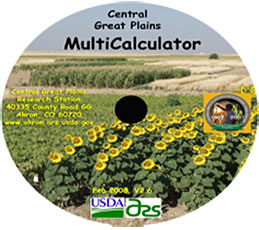T
 he device, called the MultiCalculator CD, was developed by agronomist David Nielsen at the ARS Central Great Plains Research Station in Akron, Colorado.
he device, called the MultiCalculator CD, was developed by agronomist David Nielsen at the ARS Central Great Plains Research Station in Akron, Colorado.The MultiCalculator uses three simple downloadable Excel spreadsheets.
In four steps, the yield calculator predicts non-irrigated crop yields--a vital factor in the semi-arid central plains.
First, farmers estimate how much available soil water their fields have. Farmers can tab to a table on a different screen that helps them make this estimate, giving multiplication factors for various soil types. For example, farmers on the predominant soil type in the area, silty loam, would multiply the depth of their wet soil by 2.2 to get the number of inches of soil water available for the crop at planting time.
In the next three steps, farmers choose a crop, a location, and guess the percentage of average precipitation they expect during the growing season.
The computer instantly shows the yields they can expect. The yield calculator does this for 18 crops, including cereal grains, seed legumes, oilseeds and forages.
The water calculator also works in reverse--in five steps--beginning with the farmer choosing a crop, then the target yield. It tells how much irrigation water will be needed to achieve the target yield.
 In addition, the calculator will also tell farmers how many gallons of irrigation water they will need for each gallon of ethanol produced from the corn they grow.
In addition, the calculator will also tell farmers how many gallons of irrigation water they will need for each gallon of ethanol produced from the corn they grow.The calculations are derived from data from long-term ARS research at Akron, which showed a linear relationship between crop yields and seasonal crop water use.
Home Grown
Farm Supply
Mathematical Models of Crop Growth and Yield
No comments:
Post a Comment